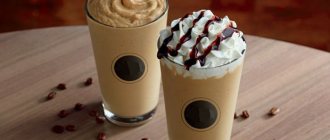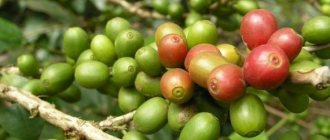How to Use Coffee Glycemic Index Data
The glycemic index of coffee is especially important for three categories of coffee drinkers:
- athletes who draw up a nutrition plan based on it to gain weight or burn fat;
- diabetic patients controlling blood sugar levels;
- adherents to the Montignac diet , based on GI foods.
For athletes, a cup of coffee before training helps them exercise more intensely and gain more energy and strength. In this case, just black natural coffee is enough, but you can also drink it with sugar.
Diabetics need to control their blood sugar levels and preferably choose low GI foods and drinks. Therefore, sweet milk-based coffee is not for them. It is better to prefer natural coffee with a few spoons of milk.
The Montignac diet recommends choosing foods with a low GI, and therefore, if you want to lose weight and adhere to the principles of this method, drink Americano, espresso or ristretto, but not much, since sugars are quickly stored in subcutaneous fat.
What is the best coffee to drink if you have diabetes?
Everyone knows that most diabetics are overweight. The situation can be corrected if foods low in instant sugar predominate in the diet.
Then the amount of fat will decrease. If you combine foods correctly in your diet, you can also lower your index and slow down the breakdown of carbohydrates and their absorption into the blood.
Combinations of carbohydrates with fat or carbohydrates with protein are considered beneficial.
Interesting! There is another concept called “glycemic load”. Products of different quality may have the same index, but different loads. For example - watermelon and bun. Their index is almost the same - 75. At the same time, the load of a bun is 30 units, of a watermelon - 6
There is also a state of hypoglycemia. If a diabetic does not have time to eat anything, but at the same time receives a dose of insulin, he comes to life in a very serious condition - an insulin crisis or shock.
Video: Nutritionist about coffee with butter
This is a dangerous situation in which you urgently need to eat something sweet with a high GI. For example, drink sweet tea or coffee. There are candies containing synthetic additives, which are not recommended - they do not raise sugar levels, since they contain fats that inhibit the absorption of sugar.
Coffee for diabetes can be consumed in reasonable dosages - 1 - 2 cups per day. This prevents premature cell aging. In this case, green grains are the best choice, as they contain more antioxidants that prevent oxidative reactions in the body. Caffeine stimulates the adrenal glands, which speed up metabolism and promote the utilization of fat in the subcutaneous tissue.
Poor metabolism affects the condition of blood vessels, but regular consumption of caffeine helps cleanse them and also frees the liver of toxins. It is known that diabetics drink a lot of water - sometimes up to 50 liters per day (this is not a typo). Swelling may be associated with this amount of fluid. The diuretic effect of caffeine helps remove excess water.
Glycemic index of coffee depending on the preparation method
The longer coffee interacts with water, the greater the percentage of caffeine and sugars transferred into the drink, which means the higher the glycemic index will be.
- Ristretto has the lowest glycemic index: the grains are in contact with water for only 15-20 seconds.
- In second place is espresso, about 30 seconds of preparation.
- In third place is coffee from drip and capsule coffee makers.
- The maximum caffeine is in a drink prepared in a Turkish or French press, or when coffee is simply poured with water and allowed to brew.
When and who should eat low GI foods?
There are special diets based on the glycemic index. They consist primarily of proteins (meat, fish, seafood), non-starchy vegetables (green peas, broccoli, eggplant, Brussels sprouts, etc.), whole grains and cereals.
Nutritionists recommend this form of food restrictions in the following cases:
- for diabetes or for its prevention;
- in cases where a person has problems with the absorption of insulin;
- for slow but long-term weight loss;
- in case of metabolic failures, since the diet helps to improve metabolism.
In the case of people with diabetes, another indicator is also taken into account - the insulin index (II). It provides information about the amount of insulin produced in the body in response to eating a particular food. Unlike GI, which takes into account exclusively carbohydrates, AI takes into account protein and fat-containing foods, as well as their combination.
The glycemic and insulin indexes of foods differ. For example, the GI of yogurt is 60, and its AI is 115. That is why it is recommended to take it into account in case of insulin resistance.
Glycemic index diet helps you lose weight safely
Glycemic index of natural coffee
If you carefully calculate the amount of sugar and energy you receive (this can be done using tables on the Internet), you may find that the data will vary slightly. On average, the glycemic index of natural coffee ranges from 42 to 52 , this difference is due to several factors:
- Type of coffee: Arabica contains 3% more sugar, but Robusta has almost 2 times more caffeine, which means its glycemic index is higher.
- Coffee variety and location: Colombian Arabica is believed to have more caffeine than the same variety from other countries. Highland varieties contain less caffeine than valley varieties.
- Features and method of preparing coffee.
Glycemic index of foods. What is important to know if you have diabetes?
Hello dear subscribers and readers. Today my article is not only for diabetics, but also for everyone who adheres to a diet and proper nutrition.
What is the glycemic index?
For diabetics, the main foods are those that are high in fiber. Carbohydrates from these foods are slowly absorbed.
Products with fast carbohydrates, refined in large quantities, increase sugar levels and lead to obesity.
To imagine the impact of blood sugar levels, you need to know in addition to XE (bread units)
,
glycemic index (GI)
of foods. And create your menu taking this indicator into account.
Glycemic index (GI) is a relative indicator of the effect of carbohydrates in food on changes in blood sugar levels.
This is an example table.
- Products with a high glycemic index:
milk, white bread, salty sticks, crackers, dry cookies, corn flakes, semolina, millet, flour and flour products, rice, stewed potatoes, mashed potatoes, fried potatoes, pineapple, watermelon, banana, grapes, melon, figs, mango, persimmon, beer, sweet carbonated drinks, chips, buns, various sweet puddings, noodles, rice porridge, waffles, condensed milk, lasagna, halva, croissants, jam, milk chocolate, muesli, rutabaga, Jerusalem artichoke , canned food, smoked meats.
High GI
can be used only if necessary to increase sugar, if there is hypoglycemia, during high physical activity (for example,
those who play sports and lead a very active lifestyle), or are engaged in heavy physical labor.
With constant consumption of foods with high GI, sugar levels remain high. Sugar is always high.
Insulin production decreases, metabolic disorders occur and, as a result, obesity.
Unspent energy is deposited on the sides, hips and abdomen.
And in diabetics, when they overeat and have high sugar levels, there is still a feeling of hunger, so they want to eat even more, but satiety with food does not occur.
Therefore, with a sedentary lifestyle and overeating, the stomach stretches and fat deposits will grow by leaps and bounds.
– Foods that have an average glycemic index:
kefir 1%, rye bread, crackers, breadcrumbs, buckwheat, corn, regular oatmeal, barley, apricots, oranges, pomegranate, unsweetened pears, tangerines, peach, lemon, whole grain bread, marshmallows, marmalade, jacket potatoes, omelet , egg, coffee without sugar, ketchup, mustard, brown rice, cocoa, processed cheese, fish cutlets, ice cream, steamed meat cutlets, liver (beef, turkey, chicken). I can’t help it - I love pork liver. But I eat very rarely. Once a month. I also make pates for sandwiches. You can read the recipes in my previous articles.
These products can be included in your menu with minor restrictions. Count bread units (BU) and monitor blood sugar levels.
- Products with a low glycemic index, containing a lot of fiber and protein:
lean meat (turkey, guinea fowl, rabbit, veal, lean pork), seafood, legumes, seeds, buckwheat, quince, lingonberries, cherries, grapefruit, gooseberries, kiwi, blackberries, strawberries, raspberries, plums, currants, blueberries, black currants, cabbage (cauliflower, broccoli, Chinese cabbage, white cabbage, Brussels sprouts, red cabbage), bell pepper, spinach, zucchini, eggplant, oregano, ginger, bran, lettuce, asparagus, seaweed , low-fat cottage cheese,
limited quantities of durum pasta,
green beans, garlic, mushrooms, shrimp, tomato juice, beets, soy sauce, lentils, dry wine, crab sticks, green peas, onions.
Low GI
It should be consumed by all diabetics, those on a diet, those who lead a sedentary lifestyle, those who are overweight, and those with infectious diseases.
But you still need to count Bread units
and calculate insulin for them.
See also the table of Bread Units
This is important for several other reasons:
- all diabetics can better control rising blood sugar. .
- food is digested much more slowly, and sugar rises and falls gradually.
- if we know what GI
is in products, then we can control weight much easier.
Good health to everyone. Thanks to all my subscribers and readers. Subscribe to my channel, rate it if you liked the article.
Source: https://zen.yandex.ru/media/id/5c0a909946ef5c00aaa7dbd1/5ca6fce8b92d8100b207a761
Glycemic index of instant coffee
Compared to a natural drink, the glycemic index of instant coffee will always be higher - from 50 to 60 . This is explained by the fact that instant drinks are made mainly from cheaper robusta beans, which contain more caffeine than Arabica. In addition, few people like the taste of instant coffee without milk and sugar, and these products further increase the glycemic index of the drink.
The highest glycemic index is for “3 in 1” powder mixtures with milk powder and sugar – 70-80.
Calculation of indicator for coffee drinks
Everyone has noticed that after drinking a cup a person becomes more cheerful, it is easier for him to start working, training, and thinking. This means that coffee contains readily available sugar, which is quickly broken down when ingested.
The GI of coffee depends on:
- Drink preparation time.
- Brewing method - natural grains or instant analogue.
- Qualities of additives – natural, synthetic.
According to the principles of the diet, which is based on GI, anyone can drink coffee, but the amount should be small, since unspent sugar is quickly distributed by the pancreas into the subcutaneous fatty tissue.
Soluble
The glycemic index of instant coffee is higher, since the product is made from robusta varieties, which contain 2 - 2.5 times more than Arabica. In addition, the composition includes various additives that replace the taste of natural coffee.
The production method involves first brewing the grounds, then evaporating aromatic substances from it, of which very little remains at the end of the cycle. Cheap varieties generally contain few natural ingredients.
The most sugar is in 3-in-1 drinks. These are coffee substitutes, synthetic cream and sugar. It is strictly not recommended for those who are losing weight or who are sick to consume them.
Natural
The glycemic index of natural coffee differs depending on the time the beans are exposed to boiling water:
- This effect is least when preparing ristretto - 15 seconds.
- Next comes espresso for 30 - 45 seconds.
- Drip coffee makers take even longer to prepare coffee.
- When directly brewed with boiling water in a press or boiled in a Turk, the glycemic index of coffee becomes the highest.
The drink also has a high rate, the grains for which are poured with cold water and left overnight to be drunk in the morning.
The glycemic index of natural coffee without sugar varies depending on the variety from 42 units to 52. It is influenced by several indicators - place of growth (mountain varieties are richer in sugar than lowland ones), variety (Arabica or Robusta), processing and preparation features.
By adding sugar, which has a GI of 75, you can significantly increase the overall potential of drinks. Natural coffee in this case will have an indicator of 60 units, instant coffee - 70. This means one serving.
With additives
Whole milk can reduce the glycemic index of coffee, but milk fat itself has an index of 30, so the total glycemic index of coffee with milk without sugar will be about 40 units - plus/minus 2, cappuccino is a little higher - 45 - 50.
The fattier the milk, the higher the GI content of drinks containing it. This applies only to natural grains. If you use milk or cream for soluble analogues, it can reach up to 55, which is on the border of the minimum norm.
The lowest rates are for espresso and Americano with milk without added sugar. Depending on the type of bean, espresso starts from 18 units, Americano from 28.
Latte has the highest value - up to 90, since it contains a lot of milk and sugar. It is the dairy component that has such a strong influence on the glycemic index.
To continue drinking coffee drinks, athletes and people maintaining their figure through diet are recommended to drink espresso, ristretto or Americano with a few spoons of milk.
Plant-based and skim milk
Plant-based milk additives in coffee do not add any harmful effects. Yes, you won’t get as high a foam with them as when using whole milk, but now we are talking about diet and completely different indicators.
Soy and almond milk allow you to add to natural coffee those microelements that caffeine washes out - primarily calcium.
It is better not to use cream of synthetic origin in food, since they contain trans fats - these are artificially synthesized fats. Such substances are not just harmful - they cause blockage of blood vessels and can provoke the development of cancer.
Instead of sugar, it is allowed to use the herb stevia or artificial sweeteners based on aspartame. This is not very healthy, but the figure will be normal.
Conclusion
- The minimum glycemic index is for ristretto or espresso with milk, but without sugar.
- The glycemic index of coffee is influenced by the type of beans, variety and place of growth, as well as the method of preparation.
- The maximum GI is for 3-in-1 instant coffee and latte, which contains a lot of milk.
- Athletes can drink coffee before training, diabetics and adherents of the Montignac diet can choose Americano, espresso or ristretto, perhaps with a small amount of milk.
Diabetes scale
This parameter appeared in nutrition science (and elsewhere) after diabetes specialists began to suspect that not all sugar-containing foods raise blood glucose levels at the same rate.
Actually, no one checked it until the 1980s. But in 1980-1981, Canadian professor David Jenkins, who was working on diabetes, decided to test the unshakable truths in practice. Glycemic index: how to use it
Are all carbohydrates necessarily deposited at the waist? Nothing like that - you just need to learn how to choose them correctly.
It turned out that, say, ice cream, which contains quite a lot of sugar, raises the level of glucose in the blood that is very important for diabetics much less than simple bread.
As a result, I had to take measurements in large quantities and figure out how to compare products and their dangers
for diabetics.
Carbohydrate chemistry
All carbohydrates are different, but in the body they are broken down and converted into glucose
- the main source of energy for the entire body.
Insulin
, produced in the pancreas, is responsible for the processing process It starts working immediately after food enters the body, and carbohydrates are processed first.
Glycemic index
It tells how quickly the concentration of glucose in the blood increases after consuming a product in comparison with the standard, which is usually taken as indicators after consuming pure glucose. Interesting? Read the help article on the glycemic index.
Depending on the speed at which carbohydrates are converted into glucose, they can be classified as so-called
slow
or
fast
.











